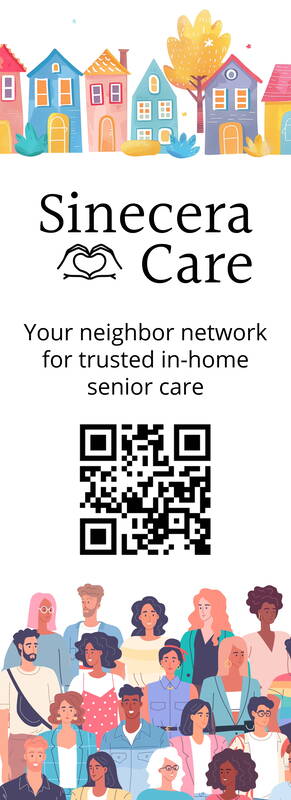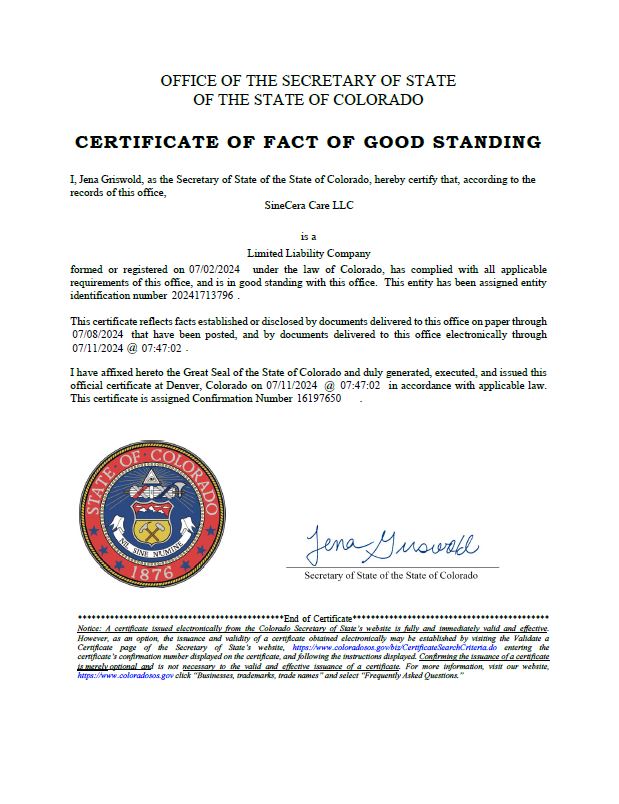COMING SOON TO YOUR NEIGHBORHOOD!... Sinecera.Care
|
The results are in - Which image(s) best capture your eldercare story?
It would appear that I am not alone in my experience as over 60% reported the images of frustration and chaos (among other derived nouns, I’m sure) as the two largest takeaways of their eldercare stories. It’s not all bad however as over 26% also reported collaboration and nurturing experiences. The efforts and folks behind these stories are no doubt extraordinary! Whether you are a neighbor, senior, family, friend, or advocate, we recognize the need for better prevention, communication, relationships, trust, and sincerity. Go far together with Sinecera Care, your neighbor network for trusted in-home senior care. |

Sinecera Care Beta Testers Wanted!
We are building an app that forms and manages a neighbor network, and we’re looking for enthusiastic volunteers who have a shared goal of helping seniors stay healthy and independent.
We aren’t looking for just anyone. We are starting with the neighborhoods and community that mean the most to us; where we live, work, and play. If you live in the Frederick, Firestone and Dacono area and would like to get involved or have a loved one or friend in the area looking for assistance or meaningful work, we would love to connect.
Sign up at Sinecera Care or by using the QR code.
Your consideration and assistance is greatly appreciated.
Go Far Together
|
I have found that everyone has an eldercare story… My eldercare story stems from my father passing away in 2021 and my wife’s father passing away earlier this year. As an engineer at my core, I’m wired to try to fix and make things better so it was frustrating and sad to see what I perceived as some potentially simple measures that could have been put in place to prevent drastic outcomes. Easier said than done as they were both stubborn as mules but that triggered my quest to talk to folks about their eldercare experiences. I was amazed to find that everyone I talked to has a very personal eldercare story regardless of age, gender, or race and encountered similar health, finance, family, and independence frustrations. I found that the need for improved eldercare is very real! What is your story… At Sinecera Care, we are strong believers in continually gaining user centric insight and gathering validation data to ensure we are addressing the real needs of eldercare and exceeding the expectations of both caregivers and seniors. As such, I am humbly requesting that you take a few minutes out of your day to share your personal eldercare story with us. There is a form on our website though the barcode or even a simple response in the comments below would be greatly appreciated! (sinecera.care) Also, if this resonates with you, please repost in your feed so we can get as much user input as possible. Thank you! A little about Sinecera Care… Sinecera Care is in the early stages of developing a SaaS (Software as a Service) solution that establishes, connects and manages a trusted-tribe network for seniors at their home, within the community, providing focused assistance and preventative care. The 2020 US Census Bureau reports that the population of elderly (age 65+) in the US has reached 55.8 million and is the largest and fastest growing in any decade since 1880 to 1890. It is estimated that 10,000 Americans turn 65 every day. Of those, 90% want to stay at home for as long as possible, 70% will need assistance at some point and 40% need assistance with daily activities. To support the country’s rising eldercare needs, it is estimated that over 1 million new caregiver jobs will be needed by 2031 and is already an enormous burden with existing eldercare organizations. Our Sinecera Care solution addresses both the caregiver and senior needs by providing an adaptive, intuitive and trusted user experience that connects neighbors to each other for the purpose of keeping seniors in their homes and neighborhoods for as long as possible. Go Far Together! |
|
Elder Care is an enormous issue in the US. With Baby Boomers well into retirement and Generation X following close behind, there is a need for a paradigm shift in home elder care that cannot be ignored. More to come... Interested in collaborating? Let's Talk! |
Need for In-Home Care Continues to Grow in Colorado and the Nation
According to a report from THE HILL, the Consumer Price Index and new data from the Bureau of Labor Statistics showed the price of in-home care for older adults increased by 14.2 percent in the year between March 2023 and 2024. Prices have similarly risen noticeably for care in assisted living facilities and nursing homes. This represents the largest percent increase in home healthcare costs during a 12-month period since the Bureau of Labor Statistics began collecting data on such costs in 2005, said THE HILL report.
Demographics is a key reason as the U.S. population ages, including among its 73 million baby boomers. The continuing shortage of in-home care workers and rising wages also figure in. “About 70 percent of American adults aged 65 and older will need some form of long-term care in the future,” the report went on to observe. It listed two main types of in-home care providers for the elderly or bed-bound: home health aides who help with personal care and homemaker aides who assist with household chores. The prices for these aides’ services vary by need and location. In 2023 the cost for homemaker or home health aide service ranged from $13 to $33 an hour in Colorado, according to insurance company Genworth.
THE HILL also cited an analysis by KFF, which does health issues analysis, showing that in 2022 there were about 4.8 million direct care workers who helped 9.8 million people at home, 1.2 million in residential care facilities, and 1.2 million in nursing homes. The direct care sector is expected to add over 1 million new jobs by 2031, according to that same analysis. But those additional jobs are not expected to be enough to meet the country’s rising eldercare needs.
Demographics is a key reason as the U.S. population ages, including among its 73 million baby boomers. The continuing shortage of in-home care workers and rising wages also figure in. “About 70 percent of American adults aged 65 and older will need some form of long-term care in the future,” the report went on to observe. It listed two main types of in-home care providers for the elderly or bed-bound: home health aides who help with personal care and homemaker aides who assist with household chores. The prices for these aides’ services vary by need and location. In 2023 the cost for homemaker or home health aide service ranged from $13 to $33 an hour in Colorado, according to insurance company Genworth.
THE HILL also cited an analysis by KFF, which does health issues analysis, showing that in 2022 there were about 4.8 million direct care workers who helped 9.8 million people at home, 1.2 million in residential care facilities, and 1.2 million in nursing homes. The direct care sector is expected to add over 1 million new jobs by 2031, according to that same analysis. But those additional jobs are not expected to be enough to meet the country’s rising eldercare needs.





